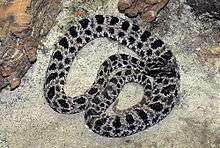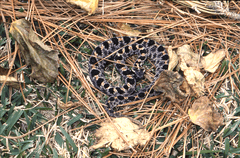Sistrurus miliarius barbouri
Sistrurus miliarius barbouri is a venomous pit viper subspecies[2] endemic to the southeastern United States.
| Sistrurus miliarius barbouri | |
|---|---|
 | |
| Scientific classification | |
| Kingdom: | Animalia |
| Phylum: | Chordata |
| Class: | Reptilia |
| Order: | Squamata |
| Suborder: | Serpentes |
| Family: | Viperidae |
| Genus: | Sistrurus |
| Species: | |
| Subspecies: | S. m. barbouri |
| Trinomial name | |
| Sistrurus miliarius barbouri | |
Common names
Common names for S. m. barbouri include Barbour's pygmy rattlesnake, dusky pygmy rattlesnake, Florida ground rattlesnake, ground rattlesnake, hog-nosed rattler, pygmy ground rattlesnake, pygmy rattler, pygmy rattlesnake, small rattlesnake, and southeastern ground rattlesnake.[3]
Etymology
The subspecific name, barbouri, is in honor of American herpetologist Thomas Barbour.[4]
Description

Adults of S. m. barbouri grow to between 35.5 and 76.0 cm (14.0 and 29.9 in) in total length, which includes the tail (Klauber, 1943). In a study that involved 103 males and 80 females, the average total length was 53.5 cm (21.1 in).[3] Snellings and Collins (1997) reported a specimen measuring 80.3 cm (31.6 in) in total length, but it had been in captivity for over 12 years. The largest reported by Gloyd (1940) was one measuring 63.8 cm (25.1 in) in total length from St. Petersburg, Florida.[5]
Regarding the coloration, this subspecies has dorsal spots that are more rounded, usually has a whitish belly that is heavily flecked or mottled with black or dark brown, and generally has 23 rows of dorsal scales at midbody.[5]
Geographic range
This subspecies, S. m. barbouri, is found in the United States from extreme southern South Carolina through southern Georgia, all of Florida, west through southern Alabama, Mississippi and Louisiana.
The type locality listed is "Royal Palm Hammock, 12 miles west of Homestead, Dade County, Florida" (USA).[1]
Reproduction
Adult females of S. m. barbouri give birth to between 5 and 7 young at a time. In a brood of 8 from Silver Springs, Marion County, Florida, each neonate measured between 157 and 173 mm (6.2 and 6.8 in) in total length.[3]
Venom
Wright and Wright (1957) include excerpts from Allen (1938) that describe how an assistant was bitten by S. m. barbouri in the Everglades and suffered severe pain and swelling for about 24 hours despite treatment. Allen also quotes some statistics: according to the Florida Reptile Institute, 28 people were bitten by this subspecies in Florida between 1935 and 1937 with no deaths.[3]
Brown (1973) gives an average venom yield of 18 mg (dried venom) (Klauber, 1956) and LD50 values of 2.8,12.6 mg/kg IV, 6.0,6.8 mg/kg IP and 24.2 mg/kg SC for toxicity.[6]
The venom contain disintegrins, notably barbourin which has a KGD (Lys-Gly-Asp) amino acid motif rather than the more common RGD (Arg-Gly-Asp) motif. This single amino acid alteration gives barbourin higher binding affinity for the fibrinogen receptor glycoprotein IIb/IIIa.[7][8] This receptor plays an important role in the aggregation of platelets, which then leads to the formation of a blood clot – competitive inhibition of this receptor by barbourin will decrease platelet aggregation, and thus reduce clotting.[9]
References
- McDiarmid RW, Campbell JA, Touré T (1999). Snake Species of the World: A Taxonomic and Geographic Reference, Volume 1. Washington, District of Columbia: Herpetologists' League. 511 pp. ISBN 1-893777-00-6 (series). ISBN 1-893777-01-4 (volume).
- "Sistrurus miliarius barbouri". Integrated Taxonomic Information System. Retrieved 1 March 2007.
- Wright AH, Wright AA (1957). Handbook of Snakes of the United States and Canada. Ithaca and London: Comstock Publishing Associates. (7th printing, 1985). 1,105 pp. ISBN 0-8014-0463-0 (Sistrurus miliarius barbouri, pp. 1055-1058, Figure 303 + Map 70 on p. 1042)..
- Beolens B, Watkins M, Grayson M (2011). The Eponym Dictionary of Reptiles. Baltimore: Johns Hopkins University Press. xiii + 296 pp. ISBN 978-1-4214-0135-5. (Sistrurus miliarius barbouri, p. 16).
- Campbell JA, Lamar WW (2004). The Venomous Reptiles of the Western Hemisphere. Ithaca and London: Comstock Publishing Associates. 870 pp. 1,500 plates. ISBN 0-8014-4141-2.
- Brown JH (1973). Toxicology and Pharmacology of Venoms from Poisonous Snakes. Springfield, Illinois: Charles C. Thomas. 184 pp. LCCCN 73-229. ISBN 0-398-02808-7.
- Markland FS (1998). "Snake Venoms and the Hemostatic System". Toxicon 36: 1749-1800.
- Scarborough RM, Rose JW, Hsu MA, Phillips DR, Campbell AM, Nannizzi L, Charo IF (1991). "Barbourin. A GPIIb-IIIa-specific integrin antagonist from the venom of Sistrurus m. barbouri ". The Journal of Biological Chemistry. 266 (15): 9359–9362. PMID 2033037.CS1 maint: multiple names: authors list (link)
- Cahill M, Mistry R, Barnett DB (1992). "The human platelet fibrinogen receptor: clinical and therapeutic significance". British Journal of Clinical Pharmacology 33: 3-9.
Further reading
- Allen ER (1938). "Florida Snake Venom Experiments". Proc. Florida Acad. Sci. 2: 70-76.
- Behler JM, King FW (1979). The Audubon Society Field Guide to North American Reptiles and Amphibians. New York: Alfred A. Knopf. 743 pp. ISBN 0-394-50824-6. (Sistrurus miliarius barbouri, p. 698 + Plate 642).
- Conant R (1975). A Field Guide to Reptiles and Amphibians of Eastern and Central North America, Second Edition. Boston: Houghton Mifflin. xviii + 429 pp. + 48 Plates. ISBN 0-395-19979-4 (hardcover), ISBN 0-395-19977-8 (paperback). (Sistrurus miliarius barbouri, p. 223 + Plate 35 + Map 177).
- Conant R, Bridges W (1939). What Snake Is That ?: A Field Guide to the Snakes of the United States East of the Rocky Mountains. (With 108 drawings by Edmond Malnate). New York and London: D. Appleton-Century Company. Frontispiece map + viii + 163 pp. + Plates A-C, 1-32. (Sistrurus miliarius barbouri, p. 144 + Plate 30, Figure 85).
- Gloyd HK (1935). "The Subspecies of Sistrurus miliarius ". Occ. Pap. Mus. Zool. Univ. Michigan (322): 1-7. ("Sistrurus miliarius barbouri, new subspecies", pp. 2–4).
- Hubbs B, O'Connor B (2012). A Guide to the Rattlesnakes and Other Venomous Serpents of the United States. Tempe, Arizona: Tricolor Books. 129 pp. ISBN 978-0-9754641-3-7. (Sistrurus miliarius barbouri, pp. 83–85).
- Schmidt KP, Davis DD (1941). Field Book of Snakes of the United States and Canada. New York: G.P. Putnam's Sons. 365 pp. (Sistrurus miliarius barbouri, p. 289).
- Smith HM, Brodie ED Jr (1982). Reptiles of North America: A Guide to Field Identification. New York: Golden Press. 240 pp. ISBN 0-307-13666-3. (Sistrurus miliarius barbouri, p. 202).
External links
| Wikimedia Commons has media related to Sistrurus miliarius. |
- Dusky pygmy rattlesnake at Florida Museum of Natural History. Accessed 1 March 2007.
- Images of Sistrurus miliarius barbouri at SREL Herpetology. Accessed 1 March 2007.
- Sistrurus miliarius barbouri at Munich AntiVenom INdex. Accessed 1 March 2008.